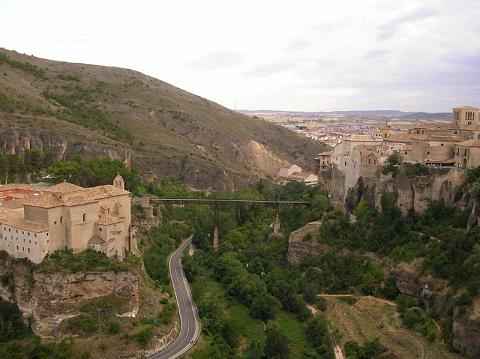There are many places that you should visit in old town of Cuenca!
Begings the tour to the old town by the Alfonso VIII street.
 On your way up to Old Town, you can enjoy a fun view, the colorful dye on the walls of the houses is very typical in Cuenca.
On your way up to Old Town, you can enjoy a fun view, the colorful dye on the walls of the houses is very typical in Cuenca. If you wanna take nice pics of this colorful landscape i'll recommend you Tintes Street and Alfonso VIII Steet.
The first stop might be the church of San Felipe Neri, a sober construction which becomes a focus at Easter week, with the singing of the traditional Miserere. Inside it is decorated with Baroque and Rococo motifs. On the other side of the Plaza del Carmen you can climb to the square of Mangana Tower, a former watchtower for Cuenca and one of the symbols of the city, visible from any other point. Very nearby is the Science Museum, with it's neo-Mudejar style was part of the Cuenca's walls defensive, so we can identify a defensive style in it's square design. I'll recommend you visit the Mangana pointview.
Before reaching the Plaza Mayor, you walk through the Plaza de la Merced, where you can see good examples of Cuenca Baroque in the church and convent of La Merced, and in the great seminary of San Julián. In the Plaza Mayor stand the arches of the Town Hall and the Gothic Cathedral of Nuestra Señora de Gracia, built on the site of a former mosque. Its structure alternates Gothic, Renaissance and Baroque elements, the result of a long period of construction. Its unfinished monumental façade accompanies the wooden balconies and wrought iron grilles of the square's aristocratic houses, whose ground floors are occupied by inns.
Next to the Cathedral is the Diocesan museum.The Museum is located in the Episcopal Palace. A large part of its collection of art belongs to the Cathedral. Visitors will find paintings and altarpieces, through to items of precious metalwork, liturgical objects, tapestries and rugs with centuries of history, taken from churches around the region.
 TIPS. In the Plaza Mayor, Take a rest and enjoy a fresh drink or a tasty meal in the inns and restaurants in Plaza Mayor. If you wanna buy some memories, there are also many craft shops, tipical food.
TIPS. In the Plaza Mayor, Take a rest and enjoy a fresh drink or a tasty meal in the inns and restaurants in Plaza Mayor. If you wanna buy some memories, there are also many craft shops, tipical food.Behind the church a street begins leading to the Hangings Houses, symbolic monuments in the city, which date from the 15th century. The hanging houses, this is also the location of the Museum of Spanish Abstract Art. This is the most popular construction, but you can find other similar houses and balconies hanging in the Jucar and Huecar Canyons.
 In front of the hanging houses you can find the St. Paul Bridge, the best and most representative of all bridges in the city of Cuenca. The St. Paul bridge connects the old town with the St. Paul Convent, this is also the location of a luxury hotel and the Torner Museum.
In front of the hanging houses you can find the St. Paul Bridge, the best and most representative of all bridges in the city of Cuenca. The St. Paul bridge connects the old town with the St. Paul Convent, this is also the location of a luxury hotel and the Torner Museum. Returning to the Cuenca urban layout, here you will find corners full of charm where there are fountains, little arches and narrow streets. Between the Cathedral and the Casas Colgadas we can also visit the Provincial Museum, the Casa del Curato, The Fundation Atonio Perez Museum and the Bishop's Palace.
The Castle quarter is the top of the City, where you can enjoy a stunning views of Cuenca landscape in the Huecar Canyon. The Castle is located in the upper part of the City. It was a Moorish fortress won by Alfonso VIII for Christians, the ruins of the gateway still remain as the Arco de Bezudo.
On the way to the highest point in the city, will be visit interesting religious buildings such the churches of San Miguel, San Nicolás and San Pedro, and the hermitage of Nuestra Señora de las Angustias. It is worth doing this tour when it is already dark and the whole city is lit up.


No comments:
Post a Comment